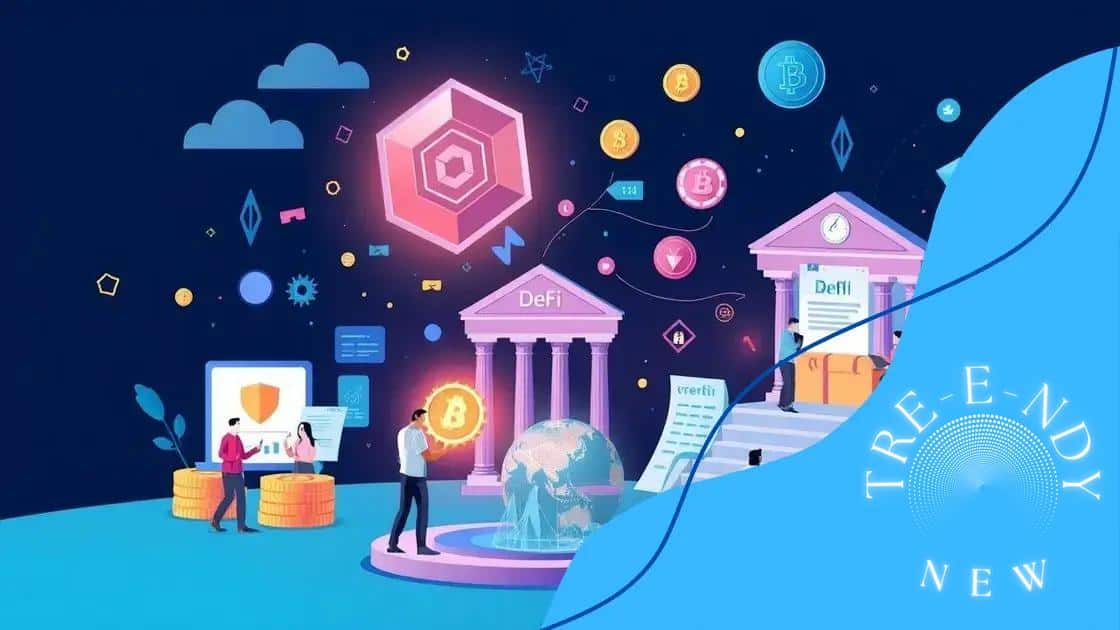Decentralized finance ecosystem growth: what’s next?

Decentralized finance (DeFi) is transforming traditional banking by enhancing accessibility, reducing fees, and providing faster transactions while posing risks such as market volatility and smart contract vulnerabilities.
Decentralized finance ecosystem growth is changing the landscape of financial services. Have you ever wondered how these innovations might shape your investments? Let’s dive into the fascinating world of DeFi.
Understanding decentralized finance and its origins
Understanding decentralized finance and its origins is vital to grasp how modern finance is evolving. Decentralized finance (DeFi) offers an open and permissionless financial system that operates independently of traditional banks.
The roots of decentralized finance can be traced to the rise of blockchain technology, which introduced a revolutionary approach to transactions. This technology enables interactions without intermediaries, fostering greater accessibility for users worldwide.
Key Components of DeFi
Several core elements contribute to the growth of decentralized finance: decentralized exchanges (DEXs), lending platforms, and stablecoins.
- Decentralized Exchanges: These platforms facilitate peer-to-peer transactions, allowing users to trade cryptocurrencies directly.
- Lending Platforms: DeFi lending allows users to borrow and lend digital assets with smart contracts, eliminating the need for traditional credit checks.
- Stablecoins: These are cryptocurrencies designed to maintain a stable value, often pegged to fiat currencies, providing stability in the volatile crypto market.
Each component plays a unique role in the ecosystem, enhancing liquidity and user empowerment. As users engage more with DeFi platforms, they tap into a system that prioritizes transparency and autonomy.
The potential of decentralized finance goes beyond just avoiding banks. It promises to democratize access to financial services globally. Users from underserved regions can participate in the financial system without the barriers imposed by traditional institutions.
Origins of DeFi
The concept of DeFi began to take shape around 2015 with the launch of Ethereum, which allowed developers to create decentralized applications (dApps). Understanding the development of this technology is crucial to acknowledge the shift it brings. As dApps gained popularity, so did the idea of creating a financial ecosystem that leverages blockchain’s capabilities.
In summary, grasping the origins and components of the decentralized finance ecosystem is essential for anyone interested in the future of finance. It highlights a movement towards a more inclusive financial landscape where everyone can participate and innovate.
Key players in the decentralized finance ecosystem
In the decentralized finance ecosystem, various players contribute to its dynamic landscape. Understanding these key actors is essential for grasping the full impact of DeFi.
One of the major players are the protocol developers. These individuals or teams create the smart contracts that power DeFi applications. Their innovations allow users to engage in lending, borrowing, and trading without intermediaries.
Major Participants in DeFi
Several groups are critical in this ecosystem:
- Users: Regular individuals who use DeFi applications to access financial services.
- Liquidity Providers: People who provide their assets to liquidity pools, earning rewards while helping maintain a stable market.
- Investor Funds: Organizations that invest in DeFi projects, often backing early-stage innovations.
- Auditors: These professionals ensure that smart contracts are secure and function without flaws, minimizing risks for users.
Each of these players holds a vital role in promoting a secure and efficient financial ecosystem. As DeFi expands, their interactions shape how this space develops, influencing everything from security to accessibility.
Furthermore, the involvement of users is crucial. They not only utilize the services but also provide feedback that drives improvements. As the community grows, it fosters innovation and attracts more participants, creating a cycle of growth.
The Influence of Community Governance
Community governance mechanisms are becoming increasingly popular in DeFi. Many platforms implement voting systems that allow users to have a say in governance decisions. This democratizes control and aligns the interests of users with those of the protocol!
In summary, understanding the key players in the decentralized finance ecosystem sheds light on its functioning. The collective efforts of protocol developers, users, liquidity providers, and others allow DeFi to thrive and evolve continuously.
How decentralized finance is changing traditional banking

Decentralized finance (DeFi) is making significant waves in traditional banking by challenging established norms and offering innovative solutions. This new financial landscape not only provides an alternative to conventional banks but also enhances the overall user experience.
One of the most apparent changes DeFi brings is financial accessibility. Unlike traditional banking systems that often require a bank account or credit history, DeFi platforms allow anyone with an internet connection to participate. This inclusivity empowers individuals who may have been excluded from the traditional banking system.
Key Changes Brought by DeFi
Several transformative aspects of decentralized finance impact traditional banking:
- Lower Fees: DeFi transactions often come with significantly lower fees than those charged by banks, making it more affordable for users.
- Faster Transactions: The speed of transactions on DeFi platforms can be much quicker than traditional banks, which often take days to process payments.
- Global Reach: DeFi operates globally without boundaries, enabling users from various countries to access the same services equally.
- Transparency: Smart contracts ensure all transactions are recorded on the blockchain, offering unprecedented transparency compared to traditional banking.
As users increasingly choose DeFi, traditional banks are forced to adapt. Many financial institutions are exploring ways to incorporate blockchain technology into their services to remain competitive. This might mean offering new services or reducing fees to keep their customers.
Additionally, customer autonomy is another hallmark of decentralized finance. Users maintain control over their funds without relying on banks, enabling them to make decisions without intermediaries. This shift leads to a more user-driven financial landscape.
Challenges for Traditional Banking
While DeFi presents exciting opportunities, it also poses challenges for traditional banking systems. Issues like regulatory compliance and security risks can make it difficult for banks to operate in the DeFi space. As the sector grows, these institutions must find ways to innovate while ensuring they adhere to laws and regulations.
In conclusion, decentralized finance is reshaping how we view money and banking, driving traditional banks to reassess their roles and adapt to a rapidly changing environment.
Risks and challenges in decentralized finance
While decentralized finance (DeFi) offers innovative solutions, it also presents various risks and challenges that participants should be aware of. Understanding these risks is vital for anyone looking to engage in the DeFi space.
One major concern is the potential for smart contract vulnerabilities. Smart contracts are the backbone of DeFi applications. However, if they contain bugs or flaws, they can be exploited by malicious actors, leading to significant financial losses.
Common Risks in DeFi
Several types of risks exist within the DeFi ecosystem:
- Market Volatility: Cryptocurrency markets are known for their price fluctuations. Sudden dips can affect asset values and cause liquidation risks.
- Regulatory Risks: DeFi operates in a grey area regarding regulations. Changes in government policies can impact platforms and their operations.
- Liquidity Risks: Some DeFi platforms may experience liquidity issues, making it hard for users to cash out or access funds.
- Rug Pulls: This occurs when developers abandon a project after attracting investment, leaving users with worthless assets.
Consideration of security measures is essential when engaging with DeFi platforms. Users should prioritize projects with strong audits and a transparent development team. Researching the history and community feedback can provide insights into potential risks.
As DeFi continues to grow, users must stay informed about the tools and strategies to mitigate these risks. Engaging with educational resources and community discussions can empower users to make informed decisions.
Challenges Facing DeFi Adoption
Despite its advantages, adoption of decentralized finance faces challenges. Many people are unfamiliar with blockchain technology, causing a knowledge gap. Additionally, user experience on some platforms can be complex, deterring newcomers.
Furthermore, the lack of consumer protection mechanisms compared to traditional finance can create hesitancy. Users who are accustomed to the safety nets provided by banks may find it hard to trust a system that operates differently.
The future of decentralized finance and its impact
The future of decentralized finance (DeFi) holds exciting possibilities that could reshape how we think about money and investments. As technology progresses, the DeFi landscape is expected to become more robust and user-friendly.
One key aspect that will drive the future of DeFi is the improvement in user experience. Many platforms today have complex interfaces that can be intimidating for new users. As developers focus on enhancing usability, we can expect more intuitive designs that attract a wider audience.
Emerging Trends in DeFi
Several trends are likely to shape the direction of decentralized finance:
- Integration with Traditional Finance: We may see more collaborations between DeFi platforms and traditional financial institutions. This could enhance mainstream acceptance.
- Interoperability: Future DeFi platforms will likely focus on allowing different protocols to work together seamlessly, increasing efficiency and access.
- Enhanced Security Measures: As the importance of security grows, innovations will emerge to better protect user assets and reduce risks.
- Regulatory Clarity: As governments provide clearer guidelines, DeFi may gain more legitimacy and attract institutional investors.
Additionally, the rise of automated finance services is expected. Users will enjoy smart contracts that handle transactions without manual intervention. This shift will push DeFi into everyday financial tasks.
Societal Impacts of DeFi
The impact of decentralized finance will extend beyond individual users. It has the potential to democratize access to financial services globally. Individuals in underbanked regions will find more opportunities to engage in economic activities. This ensures everyone can partake in wealth generation.
Furthermore, as DeFi grows, education will play a significant role. More resources will become available to help people understand blockchain technology and decentralized systems. Knowledgeable users are essential for the ecosystem’s growth.
FAQ – Frequently Asked Questions About Decentralized Finance
What is decentralized finance (DeFi)?
Decentralized finance (DeFi) refers to financial services that operate on blockchain technology without traditional intermediaries like banks.
How does DeFi improve financial accessibility?
DeFi enables anyone with an internet connection to access financial services, breaking down barriers for the underbanked or unbanked populations.
What are the main risks associated with DeFi?
Risks in DeFi include smart contract vulnerabilities, market volatility, liquidity issues, and potential regulatory challenges.
How can I ensure my assets are secure in a DeFi environment?
To enhance security, use platforms with strong audit histories, research community feedback, and enable two-factor authentication whenever possible.





